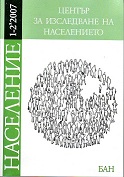ИЗВЪНБРАЧНАТА РАЖДАЕМОСТ В БЪЛГАРИЯ ПРЕЗ ХХ ВЕК
THE EXTRAMARITAL BIRTHRATE IN BULGARIA THROUGH THE XX-th CENTURY
Author(s): Maria BelchevaSubject(s): Social Sciences
Published by: Институт за изследване на населението и човека - Българска академия на науките
Summary/Abstract: The article examines the development of extramarital birthrate in Bulgaria in dependence with the basic demographic and social mother’s characteristics – age, education, occupation, social group and residence (town/village). The factors for the unwanted extramarital pregnancy are analyzed according to the results obtained from the sociological researches carried out as well as the women’s attitude to the solitary motherhood. Characteristics of the extramarital fathers are made based on their age, occupation and marital status. The social, moral and juridical problems of the extramarital children are also discussed. Demographic statistic data shows that since the beginning of the XX-th century the ratio of extramarital children to all children, has been continually growing: from 0,4% in 1901–1905, to 10,6% in 1976–1980. In the 1980s this ratio stabilizes at this level, and it remains 10–11%. Since 1990, however, there has been a boom in the number of the extramarital children: from 12,4% in 1990 it rapidly comes up to 25% in 1994 and 1995, to reach as high as 42,1% in 2001. In other words, while in 1980s each 10-th child was extramarital, nowadays almost every other child is extramarital. This process is of great dynamics, and it mirrors many other processes. The regular and rapid increase in the number of illegitimate children is a fact both in town and country, and since 1955 their ratio in the country has considerably grown in comparison with the extramarital children in cities. Extramarital birthrate is highly dependent on the age of the mother and it is highest among the youngest (<20), marking a sharp decrease in the next age groups, to be again remarkably increased with the older groups (>35). But at all age levels there is a strong tendency to extramarital delivery of children. About 13% of our contemporaries live in a free union, without being married. The children born to those families are registered as extramarital, without actually being so. Free unions are most common among young people, or among people of lower education and ethnic minorities. The ratio of these "false“ extramarital children is to be calculated at about 25–30%.
Journal: Население
- Issue Year: 2007
- Issue No: 1-2
- Page Range: 37-55
- Page Count: 19
- Language: Bulgarian
- Content File-PDF

